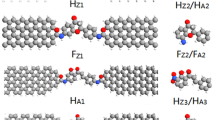Abstract
We investigated the effect of rotation of molecule on electronic transport properties in redox-based molecule devices using density functional theory and non-equilibrium Green’s function. The devices with oxidized form and reduced form exhibit a switching effect. The rotation of molecule changes the I–V characteristics of the devices, and influences the switching ratio. In addition, the rotation of molecule induces a clear negative differential resistance effect. It is concluded that the change of coupling between molecule and electrodes induced by rotating molecule determines the electronic transport of the device. The results suggest a way to modulate the electronic transport by changing the spatial distribution of molecule in molecular circuite.







Similar content being viewed by others
REFERENCES
C. C. Jia, A. Migliore, N. Xin, et al., Science (Washington, DC, U. S.) 552, 1443 (2016).
B. A. Bian, J. J. Yang, X. X. Han, et al., Eur. Phys. J. B 91, 184 (2018).
A. Aviram and M. A. Ratner, Chem. Phys. Lett. 29, 277 (1974).
P. P. Yuan, X. X. Han, J. J. Yang, et al., Phys. E (Amsterdam Neth.) 95, 32 (2018).
Z. Q. Fan, W. Y. Sun, Z. H. Zhang, et al., Carbon 122, 687 (2017).
X. X. Han, J. J. Yang, P. P. Yuan, and B. A. Bian, Eur. Phys. J. B 92, 92 (2019).
R. A. Wassel, G. M. Credo, R. R. Fuierer, et al., J. Am. Chem. Soc. 126, 295 (2004).
J. He and S. M. Lindsay, J. Am. Chem. Soc. 127, 11932 (2005).
J. M. Seminario, A. G. Zacarias, and P. A. Derosa, J. Chem. A 105, 791 (2001).
C. Li, D. H. Zhang, X. L. Liu, et al., Appl. Phys. Lett. 82, 645 (2003).
Y. Cui, Z. H. Zhong, D. L. Wang, et al., Nano Lett. 3, 149 (2003).
L. L. Chua, J. Zaumseil, J. F. Chang, et al., Nature (London, U.K.) 434, 194 (2005).
M. Feng, L. Gao, Z. T. Deng, et al., J. Am. Chem. Soc. 129, 2204 (2007).
G. Y. Jiang, Y. L. Song, X. F. Guo, et al., Adv. Mater. 20, 2888 (2008).
P. E. Kornilovitch, A. M. Bratkovsky, and R. S. Williams, Phys. Rev. B 66, 245413 (2002).
M. Kishida, T. Kusamoto, and H. Nishihara, J. Am. Chem. Soc. 136, 4809 (2014).
A. N. Pasupathy, R. C. Bialczak, J. Martinek, et al., Science (Washington, DC, U. S.) 306, 86 (2004).
E. H. van Dijk, D. J. Myles, M. H. van der Veen, and J. C. Hummelen, Org. Lett. 8, 2333 (2006).
J. Huang, Q. X. Li, H. Ren, et al., J. Chem. Phys. 127, 094705 (2007).
B. A. Bian, Y. P. Zheng, P. P. Yuan, et al., Phys. Lett. A 381, 2748 (2017).
J. J. Yang, X. X. Han, P. P. Yuan, et al., Theor. Chem. Acc. 137, 77 (2018).
C. van Dyck, V. Geskin, A. J. Kronemeijer, et al., Phys. Chem. Chem. Phys. 15, 4392 (2013).
J. J. Yang, X. X. Han, P. P. Yuan, B. A. Bian, and B. Liao, Theor. Chem. Acc. 137, 178 (2018).
L. N. Shao, J. F. Zhao, B. Cui, et al., Chem. Phys. Lett. 678, 216 (2017).
B. Gui, X. S. Meng, Y. Chen, et al., Chem. Mater. 27, 6426 (2015).
J. Taylor, H. Guo, and J. Wang, Phys. Rev. B 63, 245407 (2001).
M. Brbyge, J. L. Mozos, P. Ordejon, et al., Phys. Rev. B 65, 165401 (2002).
J. Perdew and A. Zunger, Phys. Rev. B 23, 5048 (1981).
M. Büttiker, Y. Imry, R. Landauer, and S. Pinhas, Phys. Rev. B 31, 6207 (1985).
C. V. Dyck, V. Geskin, and J. Cornil, Adv. Funct. Mater. 24, 6154 (2014).
J. M. Seminario, A. G. Zacarias, and J. M. Tour, J. Am. Chem. Soc. 122, 3015 (2000).
ACKNOWLEDGMENTS
This work is supported by National Natural Science Foundation Joint Fund Key Project under grant no. U1865206, National Science and Technology Major Project under grant no. 2017- VII-0012-0107, and Guangdong Province Key Area R & D Program under grant no. 2019B090909002.
Author information
Authors and Affiliations
Corresponding author
Ethics declarations
The authors declare that they have no conflicts of interest.
Rights and permissions
About this article
Cite this article
Wu, Y., Liao, B., Wang, G. et al. Electronic Transport Induced by Rotating Molecule in Molecular Devices. Russ. J. Phys. Chem. 96, 1044–1050 (2022). https://doi.org/10.1134/S003602442214028X
Received:
Revised:
Accepted:
Published:
Issue Date:
DOI: https://doi.org/10.1134/S003602442214028X




